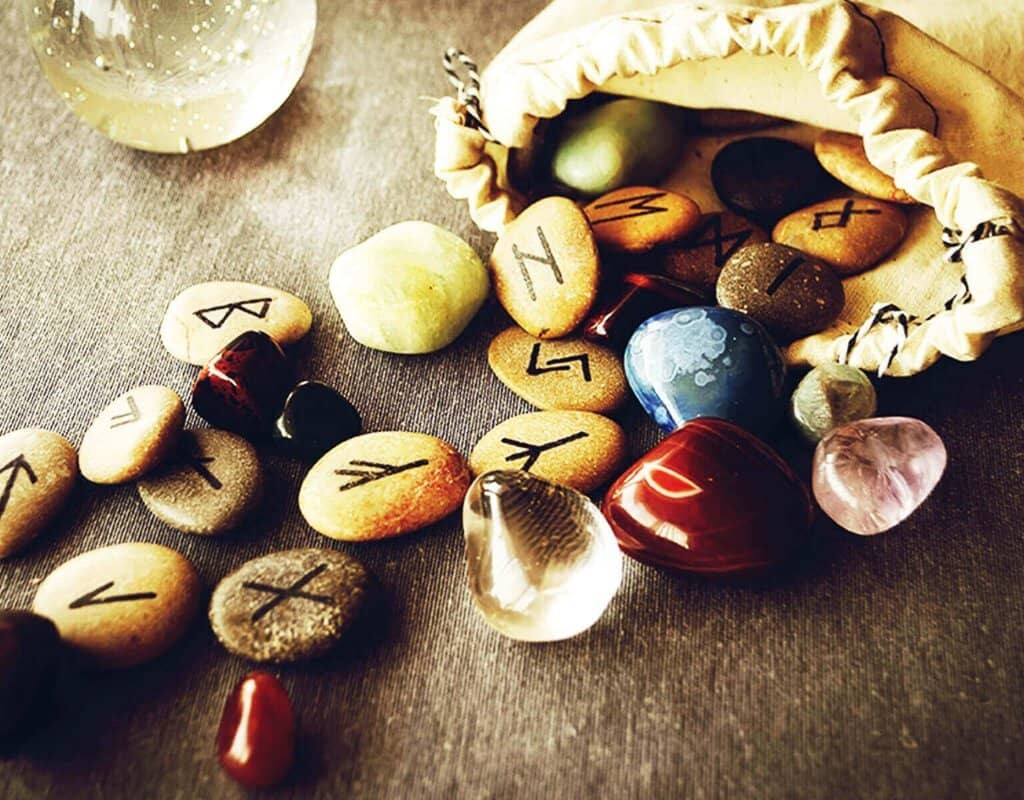The Futhark runes, an ancient Germanic alphabet, are more than just letters. These symbols are used in divination and rituals, connecting us with a rich spiritual and cultural heritage. By discovering their meanings, you can learn how to use these mystical inscriptions in your daily life to gain wisdom and guidance.
Using Futhark Runes in Rituals and Magic
The Futhark runes have their roots in ancient Germanic and Nordic cultures. This runic alphabet, composed of 24 symbols, was used for writing, divination and magical rituals. The earliest runes were believed to be carved in wood, bone and stone, dating back to approximately 200-800 AD.
The name “Futhark” comes from the first six letters of the alphabet: Fehu, Uruz, Thurisaz, Ansuz, Raidho and Kenaz. Archaeological findings of these runes in various sites from Scandinavia to Turkey and England demonstrate their widespread use and cultural importance.
Runes were a writing system and each symbol has a spiritual and magical meaning. According to Norse mythology, the knowledge of the runes was given to Odin, who hung from the Yggdrasil tree for nine days and nights to acquire their wisdom. This divine connection makes the runes powerful tools for divination and spiritual connection.
The 24 Runes of the Elder Futhark

The 24 runes of the Elder Futhark are organized into three groups of eight runes each, known as aettir (singular: aett). In Old Norse, the word aettir means “family” or “clan.”
Each aettir has its own set of meanings and symbolism, reflecting different aspects of life and spirituality. These groups help structure the runes and facilitate their study and understanding, offering a deeper insight into the connection between the runes and the universal forces they represent.
First Aettir: The Family of Fehu
Fehu ᚠ the Rune of Abundance
Fehu, the first rune of the Elder Futhark, symbolizes cattle, which in ancient Nordic cultures was the primary source of wealth. It represents abundance, material success and prosperity. When used in divination, Fehu indicates achievements and the realization of ambitions.
Uruz ᚢ the Rune of Strength
Uruz represents the aurochs, an ancient wild ox. This rune symbolizes vital force, health and physical and mental endurance. In divination, Uruz can point to challenges that strengthen or the manifestation of renewed inner power.
Thurisaz ᚦ the Rune of Defense
Thurisaz is associated with Thor and his hammer, Mjöllnir. It symbolizes defense, protection and the destruction of obstacles. In divination, Thurisaz suggests the need to break down old barriers to allow new beginnings.
Ansuz ᚨ the Rune of Communication
Ansuz is linked to Odin, the god of wisdom and communication. It represents the power of words and divine inspiration. In divination, Ansuz can indicate important messages, the need for clear communication and creative inspiration.
Raidho ᚱ the Rune of Travel
Raidho symbolizes travel and movement. It represents progress towards the desired destination and harmony with life’s purpose. In divination, Raidho indicates progress, journeys and the importance of following the right path.
Kenaz ᚲ the Rune of Transformation
Kenaz, the rune of the torch, symbolizes the light that dispels darkness. It represents creativity, passion and transformation. In divination, Kenaz suggests the awakening of inner inspiration and the need to transform energies.
Gebo ᚷ the Rune of the Gift
Gebo represents exchange and generosity. It symbolizes gifts, both material and spiritual and the balance created through giving and receiving. In divination, Gebo indicates the importance of gratitude and balanced relationships.
Wunjo ᚹ the Rune of Joy
Wunjo symbolizes joy and harmony. It represents personal fulfillment and well-being. In divination, Wunjo suggests a period of happiness, the achievement of goals and the alignment of the internal and external aspects of life.
Second Aettir: The Family of Hagalaz
Hagalaz ᚺ the Rune of Hail
Hagalaz represents hail and symbolizes temporary difficulties and disruption. It is a natural force that can cause destruction but is also necessary for renewal and change. In divination, Hagalaz indicates challenges that must be faced and overcome.
Naudhiz ᚾ the Rune of Need
Naudhiz symbolizes need and distress. It represents restriction and effort, but also the potential to overcome adversity. In divination, Naudhiz suggests the necessity to face current problems and find creative solutions.
Isa ᛁ the Rune of Ice
Isa represents ice, stillness and immobility. It symbolizes a forced pause where progress temporarily halts. In divination, Isa indicates the need for patience and reflection before proceeding with any action.
Jera ᛃ the Rune of the Harvest
Jera symbolizes the cycle of the year and the reward for past efforts. It represents the harvest and the fruits of labor. In divination, Jera suggests that the results of past actions are about to manifest and that it is a time for celebration and gratitude.
Eihwaz ᛇ the Rune of the Yew
Eihwaz represents the yew tree, a symbol of life and death. It symbolizes transformation and passing through difficult stages towards a new beginning. In divination, Eihwaz indicates the need to sacrifice something to advance and grow.
Perthro ᛈ the Rune of Fate
Perthro symbolizes fate and the lottery. It represents the mystery of the unknown and the quest for inner knowledge. In divination, Perthro suggests that fate is at play and that it is a time to explore the inner self and make decisions based on intuition.
Algiz ᛉ the Rune of Protection
Algiz represents protection and connection with the higher self. It symbolizes a safe haven and heightened awareness. In divination, Algiz indicates the need for protection against dangers and the importance of raising consciousness to avoid problems.
Sowilo ᛋ the Rune of the Sun
Sowilo symbolizes the sun and spiritual power. It represents illumination, success and personal growth. In divination, Sowilo suggests a time of expansion, clarity and success in personal and spiritual endeavors…





